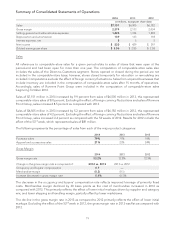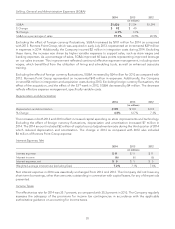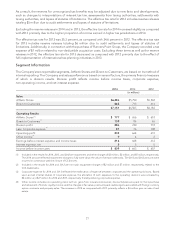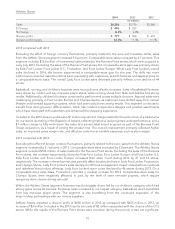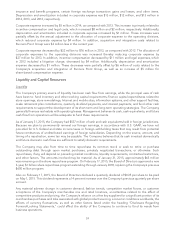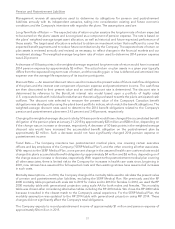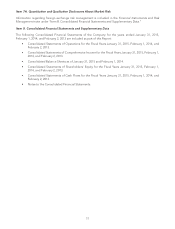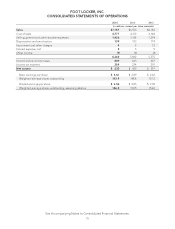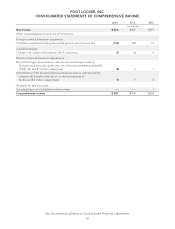Foot Locker 2014 Annual Report Download - page 52
Download and view the complete annual report
Please find page 52 of the 2014 Foot Locker annual report below. You can navigate through the pages in the report by either clicking on the pages listed below, or by using the keyword search tool below to find specific information within the annual report.
Critical Accounting Policies
Management’s responsibility for integrity and objectivity in the preparation and presentation of the financial
statements requires diligent application of appropriate accounting policies. Generally, the Company’s
accounting policies and methods are those specifically required by U.S. generally accepted accounting
principles. Included in the Summary of Significant Accounting Policies note in ‘‘Item 8. Consolidated Financial
Statements and Supplementary Data’’ is a summary of the Company’s most significant accounting policies. In
some cases, management is required to calculate amounts based on estimates for matters that are inherently
uncertain. The Company believes the following to be the most critical of those accounting policies that
necessitate subjective judgments.
Merchandise Inventories and Cost of Sales
Merchandise inventories for the Company’s Athletic Stores are valued at the lower of cost or market using the
retail inventory method (‘‘RIM’’). The RIM is commonly used by retail companies to value inventories at cost and
calculate gross margins due to its practicality. Under the retail method, cost is determined by applying a
cost-to-retail percentage across groupings of similar items, known as departments. The
cost-to-retail percentage is applied to ending inventory at its current owned retail valuation to determine the
cost of ending inventory on a department basis. The RIM is a system of averages that requires management’s
estimates and assumptions regarding markups, markdowns and shrink, among others, and as such, could result
in distortions of inventory amounts.
Significant judgment is required for these estimates and assumptions, as well as to differentiate between
promotional and other markdowns that may be required to correctly reflect merchandise inventories at the
lower of cost or market. The Company provides reserves based on current selling prices when the inventory has
not been marked down to market. The failure to take permanent markdowns on a timely basis may result in an
overstatement of cost under the retail inventory method. The decision to take permanent markdowns includes
many factors, including the current retail environment, inventory levels, and the age of the item. Management
believes this method and its related assumptions, which have been consistently applied, to be reasonable.
Impairment of Long-Lived Assets, Goodwill and Other Intangibles
The Company performs an impairment review when circumstances indicate that the carrying value of long-lived
tangible and intangible assets with finite lives may not be recoverable. Management’s policy in determining
whether an impairment indicator exists, a triggering event, comprises measurable operating performance
criteria at the division level as well as qualitative measures. If an analysis is necessitated by the occurrence of a
triggering event, the Company uses assumptions, which are predominately identified from the Company’s
strategic long-range plans, in performing an impairment review. In the calculation of the fair value of long-lived
assets, the Company compares the carrying amount of the asset with the estimated future cash flows expected
to result from the use of the asset. If the carrying amount of the asset exceeds the estimated expected
undiscounted future cash flows, the Company measures the amount of the impairment by comparing the
carrying amount of the asset with its estimated fair value. The estimation of fair value is measured by
discounting expected future cash flows at the Company’s weighted-average cost of capital. Management
believes its policy is reasonable and is consistently applied. Future expected cash flows are based upon
estimates that, if not achieved, may result in significantly different results.
The Company reviews goodwill for impairment annually during the first quarter of its fiscal year or more
frequently if impairment indicators arise. The review of impairment consists of either using a qualitative
approach to determine whether it is more likely than not that the fair value of the assets is less than their
respective carrying values or a two-step impairment test, if necessary. In performing the qualitative assessment,
management considers many factors in evaluating whether the carrying value of goodwill may not be
recoverable, including declines in stock price and market capitalization in relation to the book value of the
Company and macroeconomic conditions affecting retail. If, based on the results of the qualitative assessment,
it is concluded that it is not more likely than not that the fair value of a reporting unit exceeds its carrying value,
additional quantitative impairment testing is performed using a two-step test. The initial step requires that the
carrying value of each reporting unit be compared with its estimated fair value. The second step — to evaluate
goodwill of a reporting unit for impairment — is only required if the carrying value of that reporting unit exceeds
its estimated fair value.
29


